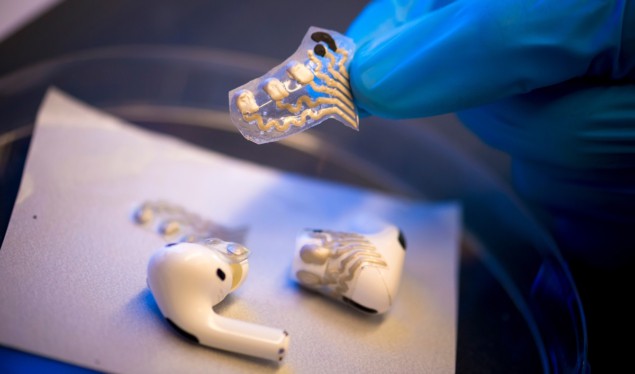Earbud biosensors provide continuous monitoring of brain activity and lactate levels
15 Nov 2023
Simultaneous sensing Flexible electrochemical and electrophysiological sensors are attached to in-ear headphones, or earbuds, via a stamp-like surface. Once the earbuds are inserted in the ear canal, the sensors simultaneously monitor brain states and exercise levels. (Courtesy: Erik Jepsen/University of California San Diego)
Earbuds equipped with biosensors can continuously measure the electrical activity of the brain and levels of the sweat secretion lactate. The device represents a potential new wearable sensing technology for detection and monitoring of neurogenerative diseases or long-term health monitoring.
Developed by a multidisciplinary team of engineers at the Center for Wearable Sensors at the UC San Diego Jacobs School of Engineering, the earbud sensors wirelessly transmit the recorded data to a smartphone or laptop computer for visual display and analysis. With this invention, the researchers foresee a future in which neuroimaging and health monitoring systems work with easily wearable sensors and mobile devices to track brain activity and levels of many health-related metabolites throughout the day.
The integration of individual brain and body signals into a single miniature platform represents a technological breakthrough for in-ear sensing technology. The researchers note that the sensors have a much smaller form factor, are less visually obtrusive and more comfortable to wear than a state-of-the-art scalp electroencephalogram (EEG) headset or commercial blood lactate meter, while offering similar performance.
“Being able to measure the dynamics of both brain cognitive activity and body metabolic state in one in-ear integrated device that doesn’t intrude on the comfort and mobility of the user opens up tremendous opportunities for advancing health and wellness of people of all ages, anytime and anywhere,” co-principal investigator Gert Cauwenberghs comments in a press statement.
When combined, EEG data, which reflect electrical activity in the brain, and measurements of sweat lactate, an organic acid produced by the body during exercise and normal metabolic activity, can be used to monitor effort during physical exercise, or to track levels of stress and focus. Such data can also be used for diagnosis of various seizures, including epileptic seizures.
Reporting their findings in Nature Biomedical Engineering, the researchers explain that in-ear electrophysiological sensing systems provide “elegant solutions to unobtrusive brain-state monitoring inside the ear canal”. The ear is located close to the central nervous system, major vasculature and the auditory cortex, providing access to physiological parameters such as EEG, pulse rate and oxygen saturation. It also has multiple exocrine sweat glands that enable analysis of vital metabolites.
The new device comprises two types of sensor screen-printed onto a 150 µm-thick flexible polymer substrate, which attaches around the earbuds. The sensors are designed to track daily activities using two principal sets of features that characterize brain–body health. The electrophysiological sensor implements a form of a wearable brain-computer interface in the ear to track brain state-related signals such as EEG and electrodermal activity.
The other sensor performs electrochemical analysis of metabolites in the ear (in this study, lactate in sweat). The electrochemical sensors are covered with a transparent, sponge-like hydrogel that acts as a mechanical cushion between the skin and sensors and improves sweat collection. They are spring-loaded to hold contact with the ear but adjust as the earbuds move.
To determine the optimal layout of the sensors, the researchers initially performed functional mapping inside the ear canal. Based on their findings, they oriented the electrophysiological electrodes towards the temporal lobe which has lower secretion of sweat, and the electrochemical electrodes towards the location with higher sweat secretion. This design minimizes potential crosstalk between the two sensors, which are separated by only 2 mm, and helps increase the signal-to-noise ratio. The team also customized the outline contour of the integrated ear sensors to match that of the earbud and one of three sizes of generic silicone tips.
The researchers validated the efficacy of their sensors by characterizing the electrode performance and the measured brain signal patterns. They also assessed the sensitivity, selectivity and long-term stability of the lactate sensors, verified the minimal crosstalk between sensors, and confirmed the mechanical and environmental stability of the integrated scanners.
The team also tested the tested the earbud sensors in healthy volunteers performing vigorous stationary cycling at a fixed level. The device detected elevated sweat lactate levels as well as changes in brain activity. Validating the collected data against results obtained from commercial dry-contact EEG headsets and lactate-containing blood samples revealed comparable data from both systems.
The lactate sensors currently require users to perform vigorous exercise or other activities that generate sweat. Without such exercise, sufficient lactate for analysis cannot be gathered, explains co-principal investigator Sheng Xu. The researchers plan to improve the design so that exercise will not be necessary for monitoring.READ MORE

Fellow co-principal investigator Patrick Mercier advises that the team’s future plans also include creating a design to process the data on the earbuds themselves, with the goal of transmitting these processed data wirelessly to a computer or smartphone. The researchers also hope that the in-ear sensors could gather additional data, such as oxygen saturation and glucose levels.
The research could also lead to new therapies. “Auditory neurofeedback coupling the measured brain signals with sound played by the device in the ear may enable potentially far-reaching new therapeutic advances for active remediation of debilitating neurological disorders such as tinnitus,” says Cauwenberghs.
Cynthia E Keen is a freelance journalist specializing in medicine and healthcare-related innovations.
from physicsworld.com 24/11/2023

Δεν υπάρχουν σχόλια:
Δημοσίευση σχολίου